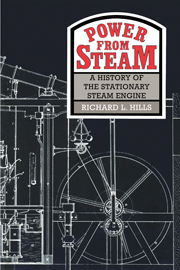Book contents
- Frontmatter
- Contents
- Preface
- Acknowledgements
- List of figures
- List of tables
- 1 The noblest machine
- 2 The impellent force of fire
- 3 Common old smoaking engines
- 4 The economy of power
- 5 The devil of rotations
- 6 Such unbounded power
- 7 Good servants but bad masters
- 8 An uncultivated field
- 9 The new theory of heat
- 10 The internal operation of the machine
- 11 Such absolute smoothness
- 12 Twinkle twinkle little arc
- 13 The drive for efficiency
- 14 An economical source of motive power
- 15 The most economical mode of obtaining power
- Notes
- Bibliography
- Index
13 - The drive for efficiency
Superheating, multiple expansion, introduction of steel (1880–1910)
Published online by Cambridge University Press: 01 June 2011
- Frontmatter
- Contents
- Preface
- Acknowledgements
- List of figures
- List of tables
- 1 The noblest machine
- 2 The impellent force of fire
- 3 Common old smoaking engines
- 4 The economy of power
- 5 The devil of rotations
- 6 Such unbounded power
- 7 Good servants but bad masters
- 8 An uncultivated field
- 9 The new theory of heat
- 10 The internal operation of the machine
- 11 Such absolute smoothness
- 12 Twinkle twinkle little arc
- 13 The drive for efficiency
- 14 An economical source of motive power
- 15 The most economical mode of obtaining power
- Notes
- Bibliography
- Index
Summary
The textile industry continued to expand in spite of various slumps up to the beginning of the First World War. Not only were more engines needed for the growing number of mills but the mills increased in size too. In Oldham, the average size of a spinning mill in 1873 was around 50,000 spindles. In 1883–4 75,000 spindles and in 1890 90,000. Gidlow Mill at Wigan must have been one of the biggest in its time for Musgrave built two horizontal engines, each with two cylinders, 40 in bore by 6 ft stroke, which have been described as ‘undoubtedly the largest simple expansion horizontal engines in a mill for many years’. They drove 154 throstle frames with 200 spindles on each, 2 pairs of mules with 600 spindles on each and 13 pairs with 1,076 spindles each, making a total of 61,376 spindles together with the preparation machinery. The increase in mill size may be seen by the Lion Mill, Royton, which was built in 1890 with 109,000 spindles, then the largest single mill. The engine here developed 2,000 h.p. When it was planned in 1898, the Nile Mill at Hollinwood with 104,000 spindles was the largest ring spinning mill in the world. In 1900, the Eclipse Mill, Rochdale, was designed to contain 118,000 spindles.
The increase in size of mills continued during the boom of the opening years of the twentieth century.
- Type
- Chapter
- Information
- Power from SteamA History of the Stationary Steam Engine, pp. 234 - 257Publisher: Cambridge University PressPrint publication year: 1989



